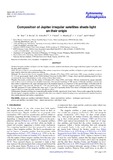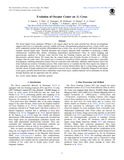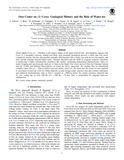Browsing by Author "Reddy, V."
Now showing items 1-3 of 3
-
Composition of Jupiter irregular satellites sheds light on their origin
Bhatt, M.; Reddy, V.; Schindler, K.; Cloutis, E.; Bhardwaj, A.; Corre, L. L.; Mann, P. (EDP Sciences, 2017)Context. Irregular satellites of Jupiter with their highly eccentric, inclined and distant orbits suggest that their capture took place after the giant planet migration. Aims. We aim to improve our understanding of the ... -
Evolution of Occator Crater on (1) Ceres
Nathues, A.; Platz, T.; Thangjam, G.; Hoffmann, M.; Mengel, K.; Cloutis, E. A.; Le Corre, L.; Reddy, V.; Kallisch, J.; D. A. Crown, D. A. (The Astronomical Journal, 2017-02-17)The dwarf planet Ceres (diameter 939 km) is the largest object in the main asteroid belt. Recent investigations suggest that Ceres is a thermally evolved, volatile-rich body with potential geological activity, a body which ... -
Oxo Crater on (1) Ceres: Geological History and the Role of Water-ice
Nathues, A.; Platz, T.; Hoffmann, M.; Thangjam, G.; Cloutis, E. A.; Applin, D. M.; Le Corre, L.; Reddy, V.; Mengel, K.; Protopapa, S.; Takir, D.; Preusker, F.; Schmidt, B. E.; Russell, C. T. (The Astronomical Journal, 2017-08-04)Dwarf planet Ceres (∅ ∼ 940 km) is the largest object in the main asteroid belt. Investigations suggest that Ceres is a thermally evolved, volatile-rich body with potential geological activity, a body that was never ...



